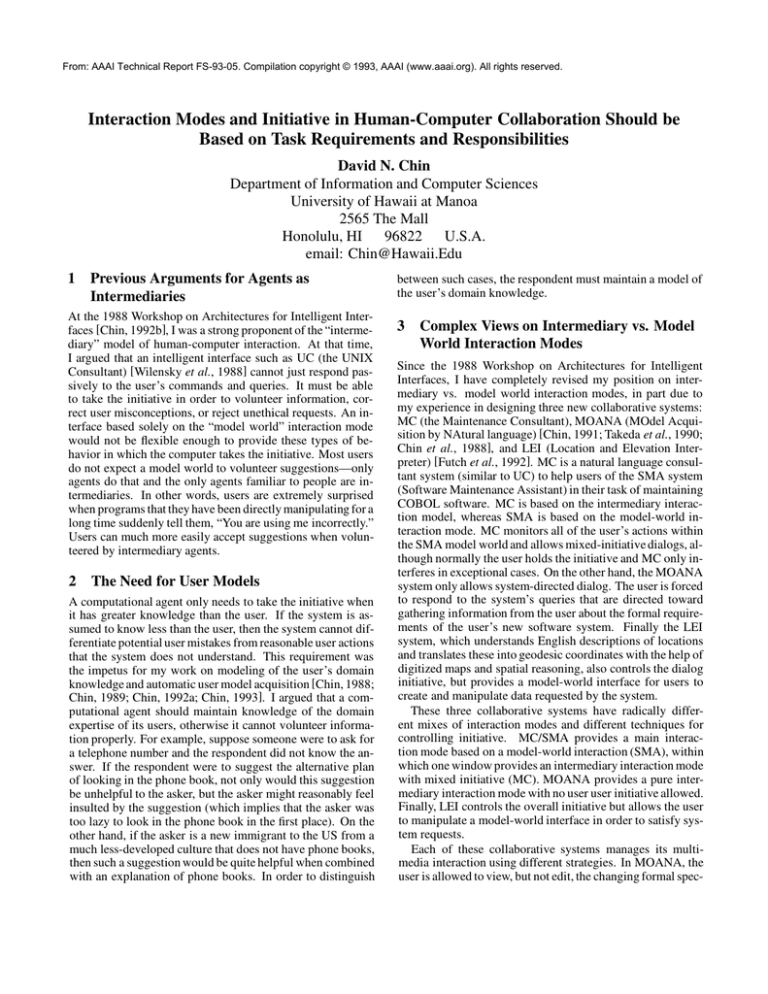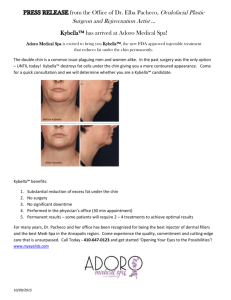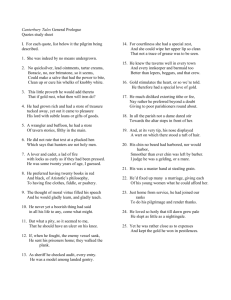
From: AAAI Technical Report FS-93-05. Compilation copyright © 1993, AAAI (www.aaai.org). All rights reserved.
Interaction Modes and Initiative in Human-Computer Collaboration Should be
Based on Task Requirements and Responsibilities
David N. Chin
Department of Information and Computer Sciences
University of Hawaii at Manoa
2565 The Mall
Honolulu, HI 96822 U.S.A.
email: Chin@Hawaii.Edu
1
Previous Arguments for Agents as
Intermediaries
At the 1988 Workshop on Architectures for Intelligent Interfaces [Chin, 1992b], I was a strong proponent of the “intermediary” model of human-computer interaction. At that time,
I argued that an intelligent interface such as UC (the UNIX
Consultant) [Wilensky et al., 1988] cannot just respond passively to the user’s commands and queries. It must be able
to take the initiative in order to volunteer information, correct user misconceptions, or reject unethical requests. An interface based solely on the “model world” interaction mode
would not be flexible enough to provide these types of behavior in which the computer takes the initiative. Most users
do not expect a model world to volunteer suggestions—only
agents do that and the only agents familiar to people are intermediaries. In other words, users are extremely surprised
when programs that they have been directly manipulating for a
long time suddenly tell them, “You are using me incorrectly.”
Users can much more easily accept suggestions when volunteered by intermediary agents.
2
The Need for User Models
A computational agent only needs to take the initiative when
it has greater knowledge than the user. If the system is assumed to know less than the user, then the system cannot differentiate potential user mistakes from reasonable user actions
that the system does not understand. This requirement was
the impetus for my work on modeling of the user’s domain
knowledge and automatic user model acquisition [Chin, 1988;
Chin, 1989; Chin, 1992a; Chin, 1993]. I argued that a computational agent should maintain knowledge of the domain
expertise of its users, otherwise it cannot volunteer information properly. For example, suppose someone were to ask for
a telephone number and the respondent did not know the answer. If the respondent were to suggest the alternative plan
of looking in the phone book, not only would this suggestion
be unhelpful to the asker, but the asker might reasonably feel
insulted by the suggestion (which implies that the asker was
too lazy to look in the phone book in the first place). On the
other hand, if the asker is a new immigrant to the US from a
much less-developed culture that does not have phone books,
then such a suggestion would be quite helpful when combined
with an explanation of phone books. In order to distinguish
between such cases, the respondent must maintain a model of
the user’s domain knowledge.
3
Complex Views on Intermediary vs. Model
World Interaction Modes
Since the 1988 Workshop on Architectures for Intelligent
Interfaces, I have completely revised my position on intermediary vs. model world interaction modes, in part due to
my experience in designing three new collaborative systems:
MC (the Maintenance Consultant), MOANA (MOdel Acquisition by NAtural language) [Chin, 1991; Takeda et al., 1990;
Chin et al., 1988], and LEI (Location and Elevation Interpreter) [Futch et al., 1992]. MC is a natural language consultant system (similar to UC) to help users of the SMA system
(Software Maintenance Assistant) in their task of maintaining
COBOL software. MC is based on the intermediary interaction model, whereas SMA is based on the model-world interaction mode. MC monitors all of the user’s actions within
the SMA model world and allows mixed-initiative dialogs, although normally the user holds the initiative and MC only interferes in exceptional cases. On the other hand, the MOANA
system only allows system-directed dialog. The user is forced
to respond to the system’s queries that are directed toward
gathering information from the user about the formal requirements of the user’s new software system. Finally the LEI
system, which understands English descriptions of locations
and translates these into geodesic coordinates with the help of
digitized maps and spatial reasoning, also controls the dialog
initiative, but provides a model-world interface for users to
create and manipulate data requested by the system.
These three collaborative systems have radically different mixes of interaction modes and different techniques for
controlling initiative. MC/SMA provides a main interaction mode based on a model-world interaction (SMA), within
which one window provides an intermediary interaction mode
with mixed initiative (MC). MOANA provides a pure intermediary interaction mode with no user user initiative allowed.
Finally, LEI controls the overall initiative but allows the user
to manipulate a model-world interface in order to satisfy system requests.
Each of these collaborative systems manages its multimedia interaction using different strategies. In MOANA, the
user is allowed to view, but not edit, the changing formal spec-
ifications (which are represented in a graphical representation
language [Takeda et al., 1992]) as they are acquired from the
user in a graphical window. In LEI, the user’s model-world
interface includes a color map for the user to manipulate. Finally, in MC/SMA, information about the maintained software is kept in a series of graphical models, so MC is able to
combine textual and graphical presentation modes as appropriate for the requested information and as appropriate to the
user’s level of familiarity with the particular graphical models used to represent the requested information. Likewise, the
user can refer to objects within the graphical model using linguistic terms such as “this relation” (referring to the relation
highlighted by the user) or “the entity on the right.”
3.1
Choosing Interaction Modes to Satisfy Task
Requirements
An analysis of the interaction modes of three collaborative
systems shows that the most important considerations in the
design of the human-computer interface are satisfying the requirements of the particular collaborative task and determining which subtasks will be handled by the user or by the program. In general, the choice of interaction modes is based on
the the number of unstructured possibilities available within
the task. If there are too many unstructured possibilities, then
it is often simpler (for the user, not the programmer) to use
a natural language interface. With only a few possibilities, a
direct manipulation interface is simpler, faster, and easier to
use. When natural language is involved, users tend to assume
an intermediary because users are predisposed to believe that
model-world interfaces do not understand natural language.
MC uses natural language because there are many possible types of queries that the user can make. Providing menus
for these query types would result in unmanageable lengths
and/or depths of menus. Providing direct-manipulation icons
for these queries would likewise result in too many icons. For
the same reason, the MOANA system uses natural language
because of the unbounded number of possible replies to many
of its queries. On the other hand, there are a limited number
of possible actions that a user can perform on a map, so the
LEI system provides a direct-manipulation environment for
its user.
This rule for choosing an interaction model should only
serve as a general guideline. One can still use natural language to handle limited possibilities or use direct manipulation to handle large numbers of unstructured possibilities. For
example, in MOANA, many queries have only a few possible
replies. MOANA lists these possibilities and asks the user to
select among them. Likewise, one can still provide a directmanipulation interface for large numbers of possible actions.
This forces users to memorize large numbers of manipulations
(e.g. the emacs editor and the TeX document formatting system) or to search through large numbers of objects/menus (e.g.
many WYSIWYG editors). However, such systems are far
from ideal and some combination of interaction models such
as found in MC/SMA may work better.
3.2
Choosing Control of Initiative Based on Task
Responsibilities
In general, control of initiative should be given to the agent
(user or program) that is primarily responsible for a particular
task. For example, LEI is mainly responsible for interpreting the English locality descriptions, so it maintains control
of the initiative until it runs into unknown words, whereupon
LEI requests clarification from the user of the geographical
meaning of the unknown words. At this point LEI passes initiative to the user to manipulate its model-world-based map
interface. After the user has finished this task, control of initiative returns to LEI. In MOANA, the system has complete
responsibility for eliciting the required information from the
user, so it never relinquishes control of dialog initiative (any
queries from the user are ignored). Finally in MC/SMA, the
user has the primary responsibility for software maintenance,
so the user holds the initiative in manipulating the main SMA
model-world graphical interface. The user is free to pass initiative to MC by providing MC with subtasks. MC relinquishes control of the initiative as soon as it has completed
its assigned task. Very infrequently, MC may seize the initiative temporarily when it detects problems.
4
Conclusions
By analyzing the three systems described above, we find
that my earlier arguments that intelligent interfaces should be
based on the intermediary interaction model were incorrect.
A system can still volunteer information without providing an
intermediary interaction model. For example, one can imagine an SMA system that has a “suggestions” window rather
than an MC window. The suggestions window volunteers information just like MC, but does not accept any natural language input from the user. Additional help can take the form
of direct manipulation of the suggestion text (e.g. by highlighting key words and then invoking an additional help button).
However, my earlier analysis of what knowledge is needed
by a collaborative system still holds: the system must model
the user’s domain knowledge not only to avoid making inappropriate suggestions, but also to select the proper mix of
multi-media formats (one should select only formats that the
user can understand). A model of the user’s domain knowledge also allows the system to augment a multi-media presentation that is only partially understandable to a particular user with additional explanatory text. Besides modeling
user knowledge, MC also models the user’s task structure and
keeps track of the user’s current progress within the task structure in order to properly interpret ambiguous requests (often
a particular interpretation of a request only makes sense for
some specific task). Other knowledge needed by MC for integrating multi-media include a context model that includes not
only the linguistic context, but also the visual context (positions and status of objects in the graphical editor and other
windows) and the history of user manipulations of objects
within SMA’s model-world interface.
Naturally, user modeling has a rather high cost in complexity. In order to keep costs down in MC, only information about
user knowledge at a course grain is kept between sessions.
For example, MC keeps track of the frequency of usage of
SMA commands (this is used to infer familiarity and expertise based on the assumption that heavier usage leads to expertise), but not of particular options of the commands. Even at
this course grain, there are hundreds of objects in MC’s hierarchy for which usage frequency statistics are kept. In order to
maintain this user model and the context model, there is considerable traffic between MC and SMA’s direct-manipulation
interfaces. For example, whenever the user manipulates anything in SMA’s graphical editor, this must be passed to MC
so that it can update its context model. Otherwise, linguistic
references to objects and actions performed by the user in the
editor would not be understandable to MC.
The bottom line for more intelligent human-computer collaboration is much higher complexity in the computer program. Just as better graphical interfaces today often consist
of more code and processing power than the actual application portion, in the future, intelligent components will require more code and processing power than the rest of the
program, including any graphical interfaces and actual application code.
References
[Chin, 1988] David N. Chin. Exploiting User Expertise in
Answer Expression. In the Proceedings of the Seventh
National Conference on Artificial Intelligence, Saint Paul,
MN, August, pages 756–760.
[Chin et al., 1988] David N. Chin., Koji Takeda, and Isao
Miyamoto. Using Natural Language and Stereotypical
Knowledge for Acquisition of Software Models. In the
IEEE International Workshop on Tools for Artificial Intelligence, Fairfax, VA, October, IEEE Computer Society
Press, Washington D.C., pages 290–295.
[Chin, 1989] David N. Chin. KNOME: Modeling What the
User Knows in UC. In A. Kobsa and W. Wahlster (Eds.),
User Models in Dialog Systems, Springer-Verlag, Berlin,
pages 74–107.
[Chin, 1991] David N. Chin. Natural Language Dialogs
for Knowledge Acquisition. In M. McTear and N. Creany (Eds.), AI and Cognitive Science ’90, Springer-Verlag,
London, pages 233–243.
[Chin, 1992a] David N. Chin. Applying User Models to Produce Cooperative Multimedia Explanation. In the AAAI
Spring Symposium Series: Producing Cooperative Explanations, Stanford, CA, March, pages 26–30.
[Chin, 1992b] David N. Chin. Intelligent Interfaces as
Agents. In J. W. Sullivan and S. W. Tyler (Eds.), Intelligent User Interfaces, Addison-Wesley, Reading, MA,
pages 177–206.
[Chin, 1993] David N. Chin. Acquiring User Models. To
appear in Artificial Intelligence Review.
[Futch et al., 1992] Shaun Futch, David N. Chin., Matthew
McGranaghan, and Jinn-Guey Lay. Spatial-Linguistic
Reasoning in LEI (Locality and Elevation Interpreter). In
A. U. Frank, I. Campari, and U. Formentini (Eds.), Theories and Methods of Spatio-Temporal Reasoning in Geographical Space. Springer-Verlag, Berlin, pages 318–327.
[Takeda et al., 1990] Koji Takeda, David N. Chin, Isao
Miyamoto. MOANA, a Software Engineering Tool with
Natural Language User Interface. In the Proceedings of
Pacific Rim International Conference on Artificial Intelligence, Nagoya, Japan, November, 1990, pages 897–902.
[Takeda et al., 1992] Koji Takeda, David N. Chin, Isao
Miyamoto. MERA: Meta Language for Software Engineering. In the Proceedings of the 4th International Conference on Software Engineering and Knowledge Engineering, Capri, Italy, June, 1992, pages 495–502.
[Wilensky et al., 1988] Robert Wilensky, David N. Chin,
Marc Luria, James Martin, James Mayfield, and Dekai Wu.
The Berkeley UNIX Consultant Project. In Computational
Linguistics, 14(4):35–84, December.




